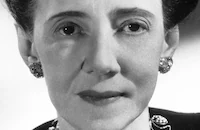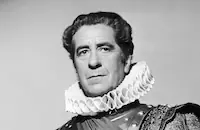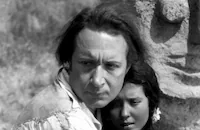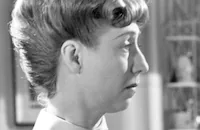I Married a Witch

Brief Synopsis
Cast & Crew
René Clair
Fredric March
Veronica Lake
Robert Benchley
Susan Hayward
Cecil Kellaway
Film Details
Technical Specs

Synopsis
In the late seventeenth century, New Englander Jonathan Wooley watches as Jennifer, whom he has accused of witchcraft, and her father Daniel, burn to death at the stake, and he recalls that the beautiful Jennifer condemned him and his descendents to perpetual unhappiness in love. An oak tree is planted over the ashes to keep in the evil spirits, but the curse against the Wooleys continues for generations until, in the modern day, a lightning bolt strikes the oak tree, releasing the spirits of Jennifer and Daniel. The spirits emerge as wisps of smoke and watch a party in the nearby house at which the impending marriage of gubernatorial candidate Wallace Wooley, a descendant and exact likeness of Jonathan, to the shrewish Estelle Masterson is being celebrated. Jennifer insists that her father grant her a corporeal body and, because the transformation process requires that she be created out of fire, he ignites the Pilgrim Hotel. Wallace, Estelle and their friend, Dr. Dudley White, are detained on their way home because of the fire, and when Wallace hears Jennifer's haunting voice calling from within the burning building, he goes in and saves her. Wallace gives Jennifer his coat because she is naked, and is perplexed by Jennifer's knowledge of him. He is further shocked when he finds her in his home after having left her at the hospital. Despite her seductive entreaties, Wallace puts Jennifer in a taxi, but the mischievous witch disappears from the car and reappears in his bedroom, remaining there until the morning. Wallace's housemaid, Margaret, is shocked to find Jennifer in his bedroom on his wedding day and, while Wallace goes out with Estelle and her father, J. B. Masterson, who is also his campaign backer, Jennifer and Daniel concoct a love potion with which to ensnare Wallace. Daniel then decides to take a corporeal form and burns another building to create himself. Wallace returns but Jennifer accidentally drinks the potion and falls desperately in love with him. That day, Daniel uses some nefarious tactics to stop the wedding but only succeeds in getting drunk and arrested. Jennifer then interrupts the ceremony by pretending to collapse, but revives the instant Wallace expresses any feeling for her. Estelle finally calls off the wedding after she finds Wallace and Jennifer kissing, and her father vows to ruin Wallace's political career. While Daniel, who is too drunk to remember any of his spells, howls to be released from jail, Wallace and Jennifer marry at a small roadside inn. Jennifer confesses to Wallace that she is a witch, but he does not believe her until she uses witchcraft to ensure that he wins the gubernatorial election, even though Masterson had spread rumors of scandal that marred his campaign. Daniel escapes from jail and insists that Jennifer be punished for revealing her nature to a mortal by imprisoning her again in the oak tree. He temporarily strips her of her powers, and despite her best efforts, Jennifer is returned to spirit form. Daniel and Jennifer watch as Wallace mourns over Jennifer's lifeless body and, to Jennifer's surprise, she unexpectedly returns to her corporeal form, thereby proving that love is stronger than witchcraft. She then traps her father in a bottle of rum, which is thereafter kept under lock and key. As time passes, Wallace and Jennifer have two sons and a daughter, Jennifer, who shows early signs of having inherited her namesake's talents.

Director
René Clair
Cast

Fredric March

Veronica Lake

Robert Benchley

Susan Hayward

Cecil Kellaway

Elizabeth Patterson

Robert Warwick

Eily Malyon
Robert Greig
Viola Moore
Mary Field
Nora Cecil
Emory Parnell
Helen St. Rayner
Aldrich Bowker
Emma Dunn
Harry Tyler
Ralph Peters
Kathryn Sheldon
Charles Moore

Ann Carter
Charles Bates
George Guhl
William Haade
Wade Boteler
Eddy Chandler

Ralph Dunn
Alan Bridge
Frank Mills
Jack Gardner
Jack Luden

Peter Leeds
Gerald Pierce
David Mckim
Donivee Lee
Billy Bletcher

James A. Millican
Arthur Stuart Hull
Georgie Cooper
Ernie Shield

Chester Conklin
Beverly Andre
Mickey Rentschler
Renny Mcevoy
Lee Shumway

Monte Blue
Robert Homans

Billy Bevan

Marie Blake
Frank Elliott
Jan Buckingham
Georgia Backus
Reed Hadley
Florence Gill
Walter Soderling
Gordon Demain
Crew
Art Black
Milton Bridenbecker
Nesta Charles
René Clair
Sam Comer
Marc Connelly
B. G. Desylva
Hans Dreier
Farciot Edouart
Ernst Fegté
Royce Finley
William Forsythe
John Gordon Gage
Edith Head
Gordon Jennings
Millard Kaufman
N. Lacey
E. D. Leshin
Eugene Liggett
Harry Mills
Richard Olson
Robert Pirosh
Leonora Sabine
George Sawley
Preston Sturges
Ted Tetzlaff
Jay Tucker
Eda Warren
Roy Webb
Wally Westmore

Photo Collections
Videos
Movie Clip



Hosted Intro






Film Details
Technical Specs

Award Nominations
Best Score
Articles
I Married a Witch - I Married a Witch
Rene Clair, the acclaimed French director of such comic masterpieces as The Italian Straw Hat (1927) and A Nous La Liberte (1931), had just completed his first American film - The Flame of New Orleans (1941) - for Universal Studios but was not offered a second film due to the poor commercial reception of the first. According to Clair in an interview with R.C. Dale for Film Quarterly, "My agent, Myron Selznick, had sent me a book, The Passionate Witch. I read it and thought I could do something with it. I met Preston (Sturges), who eventually became a good friend of mine - he spoke French as well as I do - and who was then the leading director at Paramount. We talked over the project and he agreed to produce it for me. Paramount had been trying to find something right for Veronica Lake, who had been receiving lots of publicity partly because of her beautiful hair. They didn't want an ordinary role for her, and Preston convinced them that I Married a Witch was just what they needed. That's what did it: Veronica Lake got me that job; she was a lot more important to Paramount than I was, believe me."
Almost from the beginning of production, there was friction between the two leads. One thing that couldn't have helped matters was the fact that prior to meeting his co-star, Fredric March had reportedly said Lake was "a brainless little blonde sexpot, void of any acting ability," a comment that made its way back to her. In retaliation, Lake called March a "pompous poseur" and their adversarial working relationship proceeded from there. Lake became fond of playing pranks on March; in scenes like the hotel fire where March had to pick her up and carry her, the actress placed a forty pound weight under her dress which affected March's physical stamina when several takes were required of the scene. In her autobiography, Veronica, she relates another incident involving a two shot of the couple from the waist up: "He was standing directly in front of the chair. I carefully brought my foot up between his legs. And I moved my foot up and down, each upward movement pushing it ever so slightly into his groin. Pro that he is, he never showed his predicament during the scene. But it wasn't easy for him, and I delighted in knowing what was going through his mind. Naturally, when the scene was over, he laced into me. I just smiled."
In addition to his antagonistic leads, Clair had to contend with their dissimilar acting styles; Lake was usually best on her first take while March's performance improved with each retake. In Fredric March: Craftsman First, Star Second by Deborah C. Peterson, Clair revealed that "the discrepancy between the two actors' best takes on any given shot led me to devise all sorts of tricks, including actually shooting Veronica when she thought we were still rehearsing." Clair also ran into trouble over Lake's first appearance in the film: "The censors protested because when the witch comes through the smoke, she is nude. I told them that the audience would see no more of Veronica Lake than if she were wearing an evening gown. We see only her shoulder; the rest of her is in smoke. They replied that the audience might not see her, but March would!"
In the grand tradition of The Ghost Goes West (1935) and Topper (1937), I Married a Witch makes a welcome addition to the somewhat specialized genre of comic supernatural fantasies and would later serve as the inspiration for the long-running TV series, Bewitched (1964-1972). In addition to the witty script by Robert Pirosh, Marc Connelly, and Dalton Trumbo and the spirited performances of the entire cast, the film benefits greatly from a non-stop barrage of sight gags that run the gamut from hex-induced hurricanes to spirits imprisoned in bottles to taxicabs that float in the air.
Producer/Director: Rene Clair
Screenplay: Marc Connelly, Norman Matson (novel The Passionate Witch), Robert Pirosh, Thorne Smith (novel The Passionate Witch)
Art Direction: Hans Dreier, Ernst Fegte
Cinematography: Ted Tetzlaff
Costume Design: Edith Head
Film Editing: Eda Warren
Original Music: Roy Webb
Cast: Fredric March (Wallace Wooley), Veronica Lake (Jennifer), Robert Benchley (Dr. Dudley White), Susan Hayward (Estelle Masterson), Cecil Kellaway (Daniel).
BW-77m.
by Jeff Stafford

I Married a Witch - I Married a Witch
Quotes
'Twould be nice to have lips... lips to whisper lies... lips to kiss man and make him suffer. Father, why cannot I have lips, and eyes, and hair?- Jennifer
For tonight I merry merry be / Tomorrow I'll be sober.- Daniel
I'm afraid you've got a hangover.- Wallace Wooley
Don't tell me what I've got! I invented the hangover. It was in 1892... B.C.- Daniel
It's OK. He fell out of the window.- Dr. Dudley White
Trivia
The 1960s TV show "Bewitched" (1964) was based on this movie.
Notes
The working title of this film was He Married a Witch. Information in the Paramount Collection at the AMPAS Library reveals that writer Dalton Trumbo contributed to the script, but the exact nature of his contribution to the final film has not been determined. According to modern sources, Trumbo bowed out after experiencing conflicting opinions on the interpretation of the novel with producer Preston Sturges. Although Sturges is listed as producer in various contemporary sources, modern sources indicate that he left the production before completion due to artistic differences with director René Clair, and declined screen credit. According to a modern interview, Clair worked closely with Robert Pirosh on the script.
A Hollywood Reporter news item notes that Joel McCrea was initially slated for the lead, but declined the role because he did not want to work again with Veronica Lake, previously his co-star in Sullivan's Travels (see below). Information in the Paramount Collection also notes that Patricia Morison and Walter Abel were considered for the roles of "Estelle" and "Dudley," and a Hollywood Reporter news item indicates that Margaret Hayes tested for the film. In September 1942, Paramount sold a number of pictures to United Artists for distribution, including I Married a Witch. This film was nominated for an Academy Award for Best Music (Scoring of a Dramatic or Comedy Picture).














